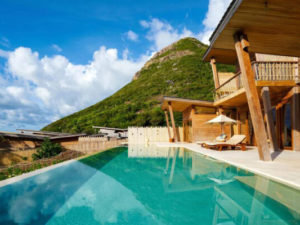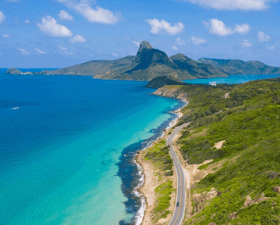When most travellers think of Vietnam, images of terraced rice fields, steaming bowls of pho, and lantern-lit streets in Hoi An often spring to mind. But beyond its cultural treasures and scenic landscapes lies a hidden world waiting to be explored — beneath the waves.
With over 3,000 kilometres of coastline, warm tropical waters, and a growing reputation among the global dive community, Vietnam is emerging as an exciting destination for scuba diving. From colourful coral reefs and diverse marine ecosystems to shipwrecks and underwater caves, the country offers a surprising variety of sites suitable for both beginners and experienced divers.
A Vietnam diving tour allows you to experience the country from a fresh perspective — far from the crowds, in tranquil waters rich with biodiversity. Whether you’re planning a short scuba diving day trip in Nha Trang, a relaxed snorkelling excursion off Phu Quoc, or a full PADI-certified dive course, there’s something here for every underwater explorer.
In this guide, we’ll reveal the best diving spots in Vietnam, the ideal times to dive, what you can expect on a tour, and why this coastal nation deserves a place on your diving bucket list.
List of Tours in Diving
✨ Tour Overview: 4-Day Luxury Escape to Phu Quoc Island Indulge in the ultimate tropical getaway with this 4-day luxury retreat to Phu Quoc Island, Vietnam’s island gem in the Gulf of Thailand. Known for its crystal-clear waters, palm-fringed beaches, and untouched natural beauty, Phu Quoc is the perfect destination for travellers seeking both relaxation...
Luxury Island Retreat: Six Senses Con Dao Experience Duration: 4 Days 3 Nights | Location: Con Dao Island, VietnamRelax, recharge, and reconnect with nature in one of Vietnam’s most exclusive island destinations. Tour Description Escape to the tranquil paradise of Con Dao Island, a hidden gem in southern Vietnam renowned for its untouched beaches, rich...
Why Choose Vietnam for Your Next Diving Adventure?
Vietnam may not yet be as internationally renowned for diving as destinations like Thailand or Indonesia, but that’s exactly what makes it so appealing. With fewer crowds, lower costs, and ever-expanding dive infrastructure, Vietnam offers a more intimate, authentic underwater experience — ideal for those seeking something off the beaten path.
Diverse Marine Environments
From shallow coral gardens to deeper reef walls, Vietnam’s underwater landscapes are surprisingly varied. Dive sites range from gentle sandy slopes perfect for beginners, to more advanced areas featuring shipwrecks, volcanic rock formations, and vibrant coral reefs teeming with tropical fish. Marine biodiversity includes clownfish, nudibranchs, cuttlefish, reef sharks, and occasionally sea turtles and rays.
Affordable and Accessible
Compared to other Southeast Asian diving destinations, scuba diving in Vietnam is very affordable. Equipment rental, dive tours, and even certification courses like PADI Open Water or Advanced Diver are often cheaper, without compromising on quality or safety. Many coastal towns — such as Nha Trang, Phu Quoc, and Hoi An — offer easy access to dive centres, making it simple to combine diving with a cultural holiday.
Great for Beginners and Certified Divers Alike
Whether it’s your first dive or your fiftieth, Vietnam has something to offer. Calm conditions, clear visibility (especially from March to September), and professional instructors make it an excellent place to try discovery diving or get certified. For more advanced divers, deeper sites and occasional drift dives offer extra challenge and variety.
Expert-Led Tours and Growing Dive Community
Vietnam’s diving industry is supported by a network of internationally certified instructors and dive centres, particularly in hotspots like Nha Trang and Phu Quoc. Many tours are run by PADI-affiliated operators who adhere to global safety and environmental standards — ensuring a trustworthy, professionally guided experience.
A Rich Cultural Backdrop
Diving in Vietnam isn’t just about the ocean. What makes the experience truly special is the ability to pair your underwater adventure with rich on-land experiences: vibrant night markets, ancient temples, UNESCO heritage sites, and world-famous Vietnamese cuisine. It’s the perfect combination of nature, culture, and adventure.
Best Diving Spots in Vietnam
Vietnam’s coastline offers a rich variety of dive sites — from vibrant coral reefs to historical shipwrecks. While still considered a “hidden gem” in the global diving scene, Vietnam has been increasingly recognised by international dive communities for its natural beauty, affordability, and diversity of marine life.
As highlighted by Scuba Diver Life, “Vietnam’s waters are ideal for newer divers looking for calm conditions, but also offer a few surprises for the more experienced, especially around remote islands.”
(Source: ScubaDiverLife.com)
Below are the top destinations you should consider when planning your Vietnam diving tour.
Nha Trang – Vietnam’s Diving Capital
Often referred to as the birthplace of recreational diving in Vietnam, Nha Trang is home to a number of well-established dive centres and calm, warm waters ideal for all levels.
- Hon Mun Marine Protected Area is the most popular spot, offering over 350 species of coral and more than 200 species of fish.
- The area is praised by PADI Travel for its biodiversity and ease of access: “Hon Mun is an excellent destination for beginners and snorkelers due to its shallow reefs and clear visibility.”
(Source: PADI Travel)
Nha Trang also offers PADI certification courses, discovery dives, and full-day trips, all at very competitive prices.
Phu Quoc – Calm Waters & Colourful Reefs
Located in the Gulf of Thailand, Phu Quoc boasts calm seas and gentle dive conditions, making it ideal for first-time divers and snorkellers.
- The An Thoi Archipelago to the south of the island is rich in hard coral and macro life, with occasional sightings of bamboo sharks and blue-spotted stingrays.
- Dive Magazine UK writes: “Phu Quoc may be low-key, but it delivers a surprisingly rich underwater experience, particularly in the dry season from November to April.”
(Source: Divemagazine.co.uk)
Con Dao – Remote, Rugged, and Rewarding
Often overlooked due to its remoteness, Con Dao is arguably Vietnam’s most pristine diving location.
- Known for wreck dives, large pelagic species, and rare encounters with green sea turtles.
- As reported by CNN Travel, “Con Dao’s isolation has helped preserve its marine environment, offering some of the most untouched coral reefs in Southeast Asia.”
(Source: CNN Travel)
Dive operators here tend to run small-group, eco-conscious tours that focus on conservation and responsible tourism.
Cham Islands (Cu Lao Cham) – UNESCO Marine Reserve
Situated just off the coast of Hoi An, the Cham Islands are part of a UNESCO Biosphere Reserve and offer some of the most accessible diving in central Vietnam.
- Great for shallow reef dives, snorkelling, and eco-focused tours.
- The marine park enforces limits on fishing and coral damage, making it an excellent example of sustainable diving tourism.
As noted by Lonely Planet, “Cham Islands are a perfect choice for travellers looking to mix cultural charm with light underwater exploration.”
(Source: Lonely Planet)
Types of Vietnam Diving Tours
Whether you’re an experienced diver seeking new thrills or a complete beginner eager to take your first breath underwater, Vietnam offers a wide range of diving tour options to suit every level and interest. Thanks to its long coastline and variety of dive sites, you can easily find a tour that matches your skillset, time frame, and travel style.
Introductory & Discovery Dives (For Beginners)
Perfect for those who have never dived before, discovery dives usually begin with a safety briefing and basic instruction from a certified dive professional. You’ll be guided one-on-one or in small groups, diving at shallow depths (usually 5–12 metres) in calm, clear waters. Locations like Phu Quoc and Cham Islands are particularly suitable for these first-time experiences.
Certified Fun Dives (Open Water & Above)
If you already hold a certification such as PADI Open Water or SSI, many operators offer guided fun dives across sites in Nha Trang, Con Dao, and Phu Quoc. These tours often include 2–3 dives in a day, with lunch and equipment included. More advanced divers can request deeper sites, wreck dives, or drift diving, depending on the location and season.
Full Dive Courses (PADI/SSI Certification)
Vietnam is an excellent place to get certified at a fraction of the cost compared to Western countries — without sacrificing safety or quality. From PADI Discover Scuba Diving to Advanced Open Water, multiple centres (especially in Nha Trang) provide full multi-day courses led by internationally licensed instructors.
According to PADI Asia-Pacific, “Vietnam’s affordability, friendly instructors, and calm dive sites make it a fast-growing destination for beginner certifications.”
(Source: PADI.com)
Snorkelling Tours (Non-divers Welcome!)
If you’re not ready to dive or simply prefer to stay near the surface, snorkelling tours are widely available at all major dive sites. These trips are family-friendly and often run in parallel with scuba tours, so groups with mixed interests can still enjoy the same locations together.
Private or Liveaboard Dive Trips (Limited but Growing)
While not as common as in places like Thailand or Indonesia, private diving charters and overnight dive cruises (liveaboards) are available on request, particularly in the Con Dao Archipelago. These are ideal for dive clubs, underwater photographers, or couples looking for a more exclusive and customised experience.
What to Expect on a Vietnam Diving Tour
Joining a diving tour in Vietnam isn’t just about diving into the water — it’s about immersing yourself in a complete experience that blends adventure, nature, safety, and hospitality. Whether you’re embarking on a half-day introduction or a multi-day diving journey, here’s what you can typically expect:
Professional, Safety-Focused Operations
Most reputable dive centres in Vietnam operate under PADI or SSI standards, ensuring that safety procedures, equipment maintenance, and instructor qualifications meet international norms. Briefings are thorough and friendly, especially for beginners, and most instructors speak fluent English or other languages commonly spoken by international travellers.
“Vietnam has come a long way in recent years when it comes to professional dive tourism. Equipment is modern, instructors are qualified, and safety is now a top priority,” notes Dive Asia Now (source: diveasianow.com).
Well-Maintained Equipment and Clean Boats
Whether you’re renting a full set of scuba gear or bringing your own, dive centres in major destinations like Nha Trang and Phu Quoc provide clean, well-maintained wetsuits, BCDs, regulators, fins, and tanks. Boats are typically equipped with shaded seating areas, freshwater showers, and sometimes even an onboard meal service.
Beautiful Marine Life & Calm Conditions
Depending on the season and location, you’ll encounter colourful coral gardens, schools of tropical fish, macro species like nudibranchs, and occasional sightings of rays or sea turtles. The majority of dive sites are known for calm currents and good visibility, especially from March to September.
Flexible Itineraries and Tour Durations
Dive tours are available in various formats:
- Half-day tours (1–2 dives) – Ideal for casual divers or travellers with limited time
- Full-day tours – Often include 2–3 dives, lunch, and surface intervals at scenic spots
- Multi-day diving packages – Popular with those taking courses or seeking variety in dive locations
Pickup from hotels, transfers to the boat, and all logistical details are usually arranged for you.
Responsible Tourism and Environmental Awareness
In recent years, many Vietnamese dive operators have become active in marine conservation efforts — from coral restoration projects to beach clean-ups. Tourists are encouraged to follow “look but don’t touch” ethics, use reef-safe sunscreen, and avoid single-use plastics.
As emphasised by Green Fins (UNEP-supported), “Vietnam’s dive operators are increasingly aware of their environmental impact, and many are now part of regional sustainability initiatives.”
(Source: greenfins.net)
When Is the Best Time to Go Diving in Vietnam?
Vietnam’s tropical climate offers year-round opportunities for diving, but the best time to dive depends on the region you plan to visit. Weather conditions, sea visibility, and marine activity can vary significantly between the north, central, and southern coasts. Choosing the right season will help ensure calm waters, good visibility, and the best overall dive experience.
Nha Trang (South-Central Vietnam)
Best time to dive: April to October
- Nha Trang enjoys its dry season during these months, offering warm sea temperatures (26–30°C), low rainfall, and visibility ranging from 10 to 20 metres.
- From November to February, rougher seas and lower visibility make diving less ideal.
According to PADI Travel, “Nha Trang is best visited for diving between late spring and early autumn, when sea conditions are at their most favourable.”
(Source: PADI Travel)
Phu Quoc (Southern Vietnam)
Best time to dive: November to April
- This period marks the island’s dry season, with calm seas and optimal visibility (up to 15 metres in good conditions).
- From May to October, the rainy season can lead to strong currents and reduced water clarity.
Dive Magazine notes: “Phu Quoc’s sheltered southern reefs are best explored during the dry months, when snorkelling and beginner dives are especially rewarding.”
(Source: Divemagazine.co.uk)
Con Dao Islands
Best time to dive: March to September
- With minimal tourist crowds and protected marine reserves, Con Dao offers excellent diving during this window, with flat seas and impressive visibility.
- From October to February, the sea can become rough, with limited dive accessibility.
Cham Islands (Hoi An, Central Vietnam)
Best time to dive: May to September
- This is the only period when diving is permitted due to weather and conservation regulations.
- The marine park opens during the dry season and closes in the rainy months for ecological protection.
As stated by UNESCO’s Biosphere Reserve management: “The Cham Islands’ seasonal dive window is essential for protecting its fragile coral ecosystems.”
(Source: UNESCO Biosphere Reserves)
Quick Summary by Region:
| Region | Best Diving Season | Visibility | Ideal For |
|---|---|---|---|
| Nha Trang | April – October | 10–20 metres | All levels, courses |
| Phu Quoc | November – April | 8–15 metres | Beginners, snorkellers |
| Con Dao | March – September | 15–25 metres | Wreck diving, advanced divers |
| Cham Islands | May – September | 10–15 metres | Eco-tours, snorkelling, beginners |
Tips for Choosing the Right Vietnam Diving Tour
With a growing number of dive operators across Vietnam, finding a tour that’s safe, enjoyable, and well-suited to your needs requires a bit of research. Whether you’re a first-time diver or a seasoned enthusiast, these tips will help you select the best diving experience for your adventure.
Choose a Reputable Dive Centre
Always book with a certified and experienced dive centre — ideally one affiliated with PADI, SSI, or another globally recognised organisation. Check that instructors are licensed, dive gear is regularly maintained, and safety procedures are clearly communicated.
According to PADI Asia-Pacific, “Choosing a certified dive centre ensures high safety standards, environmental awareness, and access to professional instructors.”
Look for companies with consistently positive reviews on platforms like TripAdvisor, Google, or DiveZone, and avoid those with unclear pricing or poorly maintained websites.
Match the Tour to Your Experience Level
- Beginners should look for tours offering Discovery Dives or Open Water certification courses, ideally in calm, shallow areas like Phu Quoc or Cham Islands.
- Certified divers may want tours that offer deeper dive sites, drift dives, or wreck dives — commonly found in Con Dao and Nha Trang.
Make sure the dive site and tour pace are appropriate for your comfort and skill level.
Ask About Group Size and Guide Ratio
Smaller groups generally mean more personalised attention and safer diving conditions — especially important for beginners. Look for tours that maintain a low diver-to-guide ratio (ideally 4:1 or less).
Consider What’s Included
Some diving tours include extras like:
- Hotel transfers
- Equipment rental
- Meals on board
- Underwater photos or videos
Clarify what’s included in the price to avoid unexpected costs later.
Inquire About Environmental Practices
Vietnam’s marine environment is still developing its conservation infrastructure, so it’s important to support eco-conscious operators. Look for companies that:
- Follow “no-touch, no-take” policies
- Use reef-safe products
- Limit plastic waste
- Partner with marine conservation organisations
Green Fins, an initiative backed by the UN Environment Programme, recommends diving responsibly to protect fragile ecosystems in Southeast Asia, including Vietnam.
(Source: GreenFins.net)
Check for Health and Safety Readiness
A good dive centre should ask for your medical history, provide a pre-dive safety briefing, and have oxygen kits and first-aid equipment on board. If you’re planning multiple dives, especially in remote areas, make sure emergency protocols are in place.
Conclusion: Dive into a Different Side of Vietnam
While Vietnam is famed for its ancient towns, flavourful street food, and rich cultural heritage, there’s a whole other world waiting beneath the surface — quiet, colourful, and full of life. A Vietnam diving tour isn’t just a water-based activity; it’s an invitation to experience the country from a fresh and unforgettable perspective.
Whether you’re swimming beside coral reefs in Nha Trang, exploring shipwrecks off the coast of Con Dao, or learning to dive in the gentle waters of Phu Quoc, each dive offers more than just scenery — it offers connection. To nature, to the ocean, and to a side of Vietnam that few tourists ever truly see.
With its accessible dive sites, professional operators, and growing eco-awareness, Vietnam is fast becoming one of Southeast Asia’s most rewarding — yet underrated — dive destinations.
So pack your fins, grab your mask, and take the plunge. Because once you’ve seen Vietnam underwater, you’ll never see it the same way again.





